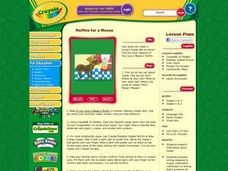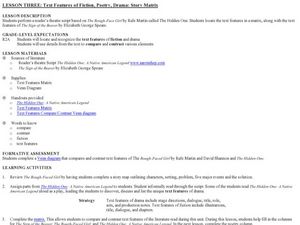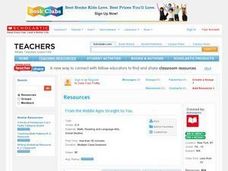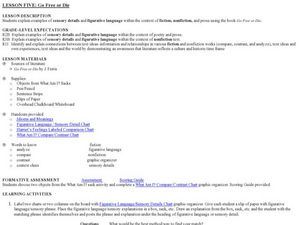Curated OER
Fabulous Fruits
Students identify several fruits, research nutrition information about each of them, and compare and contrast their findings. They design thank-you cards by creating soft color was images of fruits. They then write thank-you notes to...
Curated OER
Frog or Toad? How Can You Tell?
Students compare and contrast frogs and toads. In groups, they research the life cycle of amphibians, their life cycles, breeding habits and ways they survive. Students list words or phrases describing their amphibian. After trading...
Curated OER
Muffins for a Moose
Students research all the information they can about moose. After reading a book about the animal, they compare and contrast nonfiction and fiction books. To end the lesson, they use Crayola markets to draw their favorite scene from the...
Curated OER
My Book and Me
Learners compare and contrast a variety of books about children and then choose their favorite to incorporate into a life-size self-portrait. They examine self-portraits done by famous artists like Vincent Van Gogh, Leonardo daVinci,...
Room 108
Writing Exercise: Why Is One Color Better than Another?
Compare and contrast why one color is better than another in a short-answer format. After kids finish their writing assignment, they can also draw a picture to illustrate why one color is better.
Curated OER
Brochure Writing
Have your budding authors evaluate various writing styles found in informational brochures. They look for effective writing, compare and contrast styles, and create an assessment.
Curated OER
Elmer by David McKee
Students explore individual differences. In this literacy and self-esteem lesson plan, students listen to the story Elmo by David McKee, then describe what characteristics make Elmo special. Students complete a T chart showing how Elmo...
Curated OER
Shakespeare 2000
Young thespians can try their hand at writing a script and acting out a scene, while gaining a deeper understanding of the universal topics presented in Shakespeare's wide array of plays. Begin the instructional activity by conducting a...
Curated OER
Directed Reading Thinking Activity: Cold Sassy Tree
Lots of questions arise when reading Cold Sassy Tree. As your class encounters the twentieth chapter, encourage a rich discussion with some of the questions provided here. Then, either independently, or for homework, ask your readers to...
Curated OER
Citation Tools
Citation tools make citing textual evidence much easier. If your school is looking to compare and contrast its options, consider using this presentation to showcase some of the options currently on the market. Note: This is not a...
Curated OER
Daughters Come of Age in Women's Fiction
Introduce your young readers to fiction written by women authors. For each story, they explore the way these daughters discover and claim their own identities. Individually, class members use the literature to examine their role in their...
Curated OER
Only the Facts
Practice the strategy of summarizing to gain meaning and knowledge from an informational text. Young readers highlight supporting details and main ideas, and then they use this to summarize two articles: "The Great Quake" and "What...
Curated OER
Text Features of Fiction, Poetry, Drama: Story Matrix
How do novels differ from plays? Explore with your class the text features of fiction and drama by reading The Hidden One: Native American Legend and then performing a reader’s theater script based on the story. Class members create a...
Curated OER
Analyzing Messages in Various Media
Explore communication through media by analyzing different advertisements and artwork. Budding artists view videos, websites, plays, and other artistic endeavors while discussing the true meaning of the work with their classmates. They...
Curated OER
For the Record
Students read a New York Times article in order to examine the importance of cultural artifacts. They create essays from the point of view of one cultural artifact to demonstrate the knowledge they gained by doing research.
Curated OER
From the Middle Ages Straight to You
Learners read a "letter" from Dr. Suess' Bartholomew Cubbins and note differences between their lives and Bartholomew's. They utilize prewriting strategies to draft a letter of response to Bartholomew.
Curated OER
The Good, the Bad, and the Goofy
Upper elementary learners read about jobs on a cattle drive and the lives of cowboy during U.S. Westward Expansion. They create a "Help Wanted" poster for one of the jobs. After reading primary source accounts of cowboys, they write...
Curated OER
Read All About it
Learners create and publish a newspaper that reflects and explains pioneer and medieval societies. They become newspaper writers for a specific time period. They adopt a holistic approach to exploring community life in medieval and...
Curated OER
Non-Fiction Text Features
Distinguish between textual features of non-fiction in the book The Lewis and Clark Expedition and in the non-fiction story "Ta-Na-e-Ka." Third graders create posters and participate in group discussions to show their...
Curated OER
Go Free or Die: Figurative Language
Figures of speech, sensory details, and academic language are all targeted while reading Chapter Two of J. Ferris’ Go Free or Die. First, learners engage in an exercise to practice describing with detail. Then, partners use a...
Curated OER
Locate Key Information in Nonfiction Text
Interpret nonfiction text with your class. Readers use key information found in nonfiction text to answer questions and problem solve. They utilize the chapter headings, diagrams, glossary, maps, and captions as well as the table of...
Curated OER
Using Social Studies in Five Shared Reading Lessons: Geography
After several short 15-minute mini-lessons, your learners will gain an understanding of the characteristics of a non-fiction text. Using the book Map It by Elspeth Leacock, your class will become acquainted with non-fiction terms...
Media Smarts
Facing TV Violence: Consequences and Media Violence
Make your class aware of the difference between media violence and real violence. Using prior knowledge, a video clip, and a worksheet, class members explore and discuss the unrealistic portrayal of violence in the media. Learners...
Curated OER
'Me Fail English? That's Unpossible' : Studying Literature with "The Simpsons"
Does your class love The Simpsons? It might seem dated, but with reruns constantly popping up on television, this show still holds the attention of most of your learners. Play the opening sequence of an episode, and brainstorm any...

























